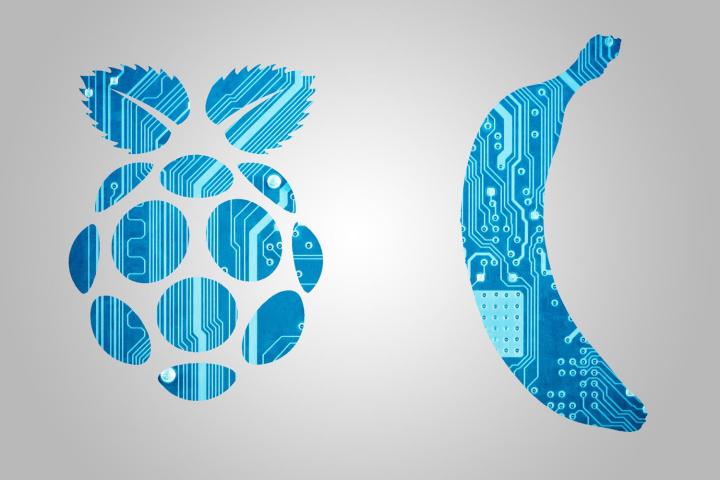
Performance
Before the recent hardware revision of the Raspberry Pi, the Banana Pi was intended to improve on the performance of the Raspberry version, adding in a faster processor and more RAM. In doing so, Banana Pi manufacturer LeMaker wanted to ensure it didn’t cause any compatibility problems.
While this may have been true before the second version of the Raspberry Pi, the improved CPU and RAM allotment in the early 2015 revision brought the two devices a lot closer together than they were before. The Raspberry offers four cores clocked at 900MHz, while the Banana offers two cores clocked at 1GHz.
When it comes to performance now, the difference is much more dependent on the software you’re running, and whether it would benefit more from additional processor cores or a higher speed single core. The video processor in the Raspberry Pi is also a bit more advanced than the Mali GPU in the Banana Pi, so if you plan on using HDMI out for media streaming or playback, the Raspberry might be a better choice.
Connectivity
While most of the connectivity options are similar across both platforms, there are a few key differences that are worth pointing out. The first is that while the Raspberry Pi relies on MicroSD and USB for storage, the Banana Pi is outfitted with a SATA port that allows a faster, more permanent option for connecting mass storage devices like hard drives. That could make a huge difference in your build if you need access to a large drive to read and write consistently.
Both devices have Ethernet ports for wired network connectivity, with gigabit available in the Banana Pi. Not a huge difference since a lot of devices have limited support for gigabit anyway. However, if you choose to step up to the Pro version of the Banana Pi, you’ll find the board has built-in Wi-Fi with 802.11n support, which can simplify a lot of projects without tying up a USB port. The Raspberry offers no such option.
Other considerations
The Raspberry Pi’s design is centered around its budget-friendliness and ease of use, which are the reasons it became so popular in the maker community. The widespread support of other users only compounds the usefulness of the device, with a wealth of information on writing and compiling software, hardware built specifically for the Pi, and more tutorials for projects than you can count. While these resources exist for Banana Pi, they aren’t nearly as comprehensive or common, which is especially tricky since the Banana Pi is a bit harder to set up than the Raspberry Pi.
If you’re used to the quality and footprint of the Raspberry Pi, you might not be very impressed by the Banana’s look and feel. It’s only a bit wider and longer than the Raspberry Pi, which should only make a difference in that you have to buy a different case, or possibly expand the slot for the computer if you’re upgrading. Some users have reported that the build quality on the Banana Pi isn’t as nice as on the Raspberry, with some unclean connections and hastily soldered joints. There’s also the issue of the processor, which has been mounted to the bottom of the board rather than the top. Since the CPU generates the most heat of any of the components, you’ll need to take its location into account when building it into your projects or putting together a case for it.
Conclusion
While the Banana Pi may have been a notable improvement over the older versions of the Raspberry Pi, the newer hardware revision renders the performance boost mostly negligible. Additionally, the lack of support for the Banana Pi, along with the higher price tag, makes it hard to recommend over the Raspberry Pi 2 Model B. If built-in Wi-Fi is really a priority, or you plan on using it for mass storage through SATA, the Banana Pi is an option, but you could set up both of those features on a Raspberry Pi without much trouble.
[Raspberry Pi is a trademark of the Raspberry Pi corporation]
Editors' Recommendations
- The 4 best Raspberry Pi alternatives in 2024
- Watch this developer use a Raspberry Pi to revive a guitar amp
- Arduino vs. Raspberry Pi
- Raspberry Pi celebrates its eighth birthday with a serious price cut
- Powerful upgrades turn 4th-gen Raspberry Pi into a more capable $35 desktop




